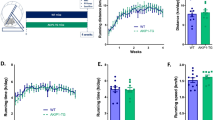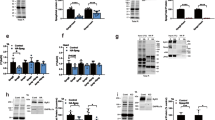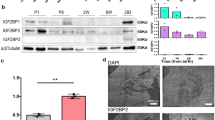Abstract
Hypertrophic heart disease is a leading health problem in Western countries. Here we identified the small EF hand domain–containing protein Ca2+ and integrin–binding protein-1 (CIB1) in a screen for previously unknown regulators of cardiomyocyte hypertrophy. Yeast two-hybrid screening for CIB1-interacting partners identified a related EF hand domain–containing protein, calcineurin B, the regulatory subunit of the prohypertrophic protein phosphatase calcineurin. CIB1 localizes primarily to the sarcolemma in mouse and human myocardium, where it anchors calcineurin to control its activation in coordination with the L-type Ca2+ channel. CIB1 protein amounts and membrane association were enhanced in cardiac pathological hypertrophy, but not in physiological hypertrophy. Consistent with these observations, Cib1-deleted mice showed a marked reduction in myocardial hypertrophy, fibrosis, cardiac dysfunction and calcineurin–nuclear factor of activated T cells (NFAT) activity after pressure overload, whereas the degree of physiologic hypertrophy after swimming exercise was not altered. Transgenic mice with inducible and cardiac-specific overexpression of CIB1 showed enhanced cardiac hypertrophy in response to pressure overload or calcineurin signaling. Moreover, mice lacking Ppp3cb (encoding calcineurin A, β isozyme) showed no enhancement in cardiac hypertrophy associated with CIB1 overexpression. Thus, CIB1 functions as a previously undescribed regulator of cardiac hypertrophy through its ability to regulate the association of calcineurin with the sarcolemma and its activation.
This is a preview of subscription content, access via your institution
Access options
Subscribe to this journal
Receive 12 print issues and online access
$209.00 per year
only $17.42 per issue
Buy this article
- Purchase on Springer Link
- Instant access to full article PDF
Prices may be subject to local taxes which are calculated during checkout






Similar content being viewed by others
References
Rosamond, W. et al. Heart disease and stroke statistics–2008 update: a report from the American Heart Association Statistics Committee and Stroke Statistics Subcommittee. Circulation 117, e25–e146 (2008).
Levy, D., Larson, M.G., Vasan, R.S., Kannel, W.B. & Ho, K.K. The progression from hypertension to congestive heart failure. J. Am. Med. Assoc. 275, 1557–1562 (1996).
Heineke, J. & Molkentin, J.D. Regulation of cardiac hypertrophy by intracellular signalling pathways. Nat. Rev. Mol. Cell Biol. 7, 589–600 (2006).
Bueno, O.F., van Rooij, E., Molkentin, J.D., Doevendans, P.A. & De Windt, L.J. Calcineurin and hypertrophic heart disease: novel insights and remaining questions. Cardiovasc. Res. 53, 806–821 (2002).
Buch, M.H. et al. The sarcolemmal calcium pump inhibits the calcineurin/nuclear factor of activated T-cell pathway via interaction with the calcineurin A catalytic subunit. J. Biol. Chem. 280, 29479–29487 (2005).
Frey, N., Richardson, J.A. & Olson, E.N. Calsarcins, a novel family of sarcomeric calcineurin-binding proteins. Proc. Natl. Acad. Sci. USA 97, 14632–14637 (2000).
Heineke, J. et al. Attenuation of cardiac remodeling after myocardial infarction by muscle LIM protein-calcineurin signaling at the sarcomeric Z-disc. Proc. Natl. Acad. Sci. USA 102, 1655–1660 (2005).
Jeong, D. et al. PICOT attenuates cardiac hypertrophy by disrupting calcineurin-NFAT signaling. Circ. Res. 102, 711–719 (2008).
Politino, M. & King, M.M. Calcineurin-phospholipid interactions. Identification of the phospholipid-binding subunit and analyses of a two-stage binding process. J. Biol. Chem. 265, 7619–7622 (1990).
Tandan, S. et al. Physical and functional interaction between calcineurin and the cardiac L-type Ca2+ channel. Circ. Res. 105, 51–60 (2009).
Saito, T. et al. Structure, expression profile, and chromosomal location of a mouse gene homologous to human DNA-PKcs interacting protein (KIP) gene. Mamm. Genome 10, 315–317 (1999).
Shock, D.D. et al. Calcium-dependent properties of CIB binding to the integrin alphaIIb cytoplasmic domain and translocation to the platelet cytoskeleton. Biochem. J. 342, 729–735 (1999).
Stabler, S.M., Ostrowski, L.L., Janicki, S.M. & Monteiro, M.J. A myristoylated calcium-binding protein that preferentially interacts with the Alzheimer's disease presenilin 2 protein. J. Cell Biol. 145, 1277–1292 (1999).
Gentry, H.R. et al. Structural and biochemical characterization of CIB1 delineates a new family of EF-hand–containing proteins. J. Biol. Chem. 280, 8407–8415 (2005).
Naik, M.U. & Naik, U.P. Calcium- and integrin-binding protein regulates focal adhesion kinase activity during platelet spreading on immobilized fibrinogen. Blood 102, 3629–3636 (2003).
Haataja, L., Kaartinen, V., Groffen, J. & Heisterkamp, N. The small GTPase Rac3 interacts with the integrin-binding protein CIB and promotes integrin αIIbβ3-mediated adhesion and spreading. J. Biol. Chem. 277, 8321–8328 (2002).
Leisner, T.M., Liu, M., Jaffer, Z.M., Chernoff, J. & Parise, L.V. Essential role of CIB1 in regulating PAK1 activation and cell migration. J. Cell Biol. 170, 465–476 (2005).
Naik, U.P., Patel, P.M. & Parise, L.V. Identification of a novel calcium-binding protein that interacts with the integrin αIIb cytoplasmic domain. J. Biol. Chem. 272, 4651–4654 (1997).
Jarman, K.E., Moretti, P.A., Zebol, J.R. & Pitson, S.M. Translocation of sphingosine kinase 1 to the plasma membrane is mediated by calcium and integrin binding protein 1. J. Biol. Chem. 285, 483–492 (2010).
Yuan, W. et al. CIB1 is essential for mouse spermatogenesis. Mol. Cell. Biol. 26, 8507–8514 (2006).
Zayed, M.A. et al. CIB1 regulates endothelial cells and ischemia-induced pathological and adaptive angiogenesis. Circ. Res. 101, 1185–1193 (2007).
Sanbe, A. et al. Reengineering inducible cardiac-specific transgenesis with an attenuated myosin heavy chain promoter. Circ. Res. 92, 609–616 (2003).
Molkentin, J.D. et al. A calcineurin-dependent transcriptional pathway for cardiac hypertrophy. Cell 93, 215–228 (1998).
Bueno, O.F. et al. Impaired cardiac hypertrophic response in calcineurin Aβ-deficient mice. Proc. Natl. Acad. Sci. USA 99, 4586–4591 (2002).
Häger, M. et al. Cib2 binds integrin α7bβ1d and is reduced in laminin α2 chain-deficient muscular dystrophy. J. Biol. Chem. 283, 24760–24769 (2008).
Zhu, J., Stabler, S.M., Ames, J.B., Baskakov, I. & Monteiro, M.J. Calcium binding sequences in calmyrin regulates interaction with presenilin-2. Exp. Cell Res. 300, 440–454 (2004).
Frey, N., Katus, H.A., Olson, E.N. & Hill, J.A. Hypertrophy of the heart: a new therapeutic target? Circulation 109, 1580–1589 (2004).
DeBosch, B. et al. Akt1 is required for physiological cardiac growth. Circulation 113, 2097–2104 (2006).
Brancaccio, M. et al. Melusin, a muscle-specific integrin β1-interacting protein, is required to prevent cardiac failure in response to chronic pressure overload. Nat. Med. 9, 68–75 (2003).
Parsons, S.A. et al. Genetic loss of calcineurin blocks mechanical overload-induced skeletal muscle fiber type switching but not hypertrophy. J. Biol. Chem. 279, 26192–26200 (2004).
Bourajjaj, M. et al. NFATc2 is a necessary mediator of calcineurin-dependent cardiac hypertrophy and heart failure. J. Biol. Chem. 283, 22295–22303 (2008).
Wilkins, B.J. et al. Targeted disruption of NFATc3, but not NFATc4, reveals an intrinsic defect in calcineurin-mediated cardiac hypertrophic growth. Mol. Cell. Biol. 22, 7603–7613 (2002).
Li, W. & Handschumacher, R.E. Identification of two calcineurin B-binding proteins: tubulin and heat shock protein 60. Biochim. Biophys. Acta 1599, 72–81 (2002).
Politino, M. & King, M.M. Calcium- and calmodulin-sensitive interactions of calcineurin with phospholipids. J. Biol. Chem. 262, 10109–10113 (1987).
Iida, T., Egusa, H., Saeki, M., Yatani, H. & Kamisaki, Y. PICK1 binds to calcineurin B and modulates the NFAT activity in PC12 cells. Biochem. Biophys. Res. Commun. 375, 655–659 (2008).
Wilkins, B.J. et al. Calcineurin/NFAT coupling participates in pathological, but not physiological, cardiac hypertrophy. Circ. Res. 94, 110–118 (2004).
Heineke, J. et al. Downregulation of cytoskeletal muscle LIM protein by nitric oxide: impact on cardiac myocyte hypertrophy. Circulation 107, 1424–1432 (2003).
Lim, H.W. et al. Calcineurin expression, activation and function in cardiac pressure-overload hypertrophy. Circulation 101, 2431–2437 (2000).
Parsons, S.A., Millay, D.P., Sargent, M.A., McNally, E.M. & Molkentin, J.D. Age-dependent effect of myostatin blockade on disease severity in a murine model of limb-girdle muscular dystrophy. Am. J. Pathol. 168, 1975–1985 (2006).
Hilfiker-Kleiner, D. et al. A cathepsin D–cleaved 16 kDa form of prolactin mediates postpartum cardiomyopathy. Cell 128, 589–600 (2007).
Haq, S. et al. Differential activation of signal transduction pathways in human hearts with hypertrophy versus advanced heart failure. Circulation 103, 670–677 (2001).
Liu, Q., Wilkins, B.J., Lee, Y.J., Ichijo, H. & Molkentin, J.D. Direct interaction and reciprocal regulation between ASK1 and calcineurin-NFAT control cardiomyocyte death and growth. Mol. Cell. Biol. 26, 3785–3797 (2006).
Vila-Carriles, W.H., Zhou, Z.H., Bubien, J.K., Fuller, C.M. & Benos, D.J. Participation of the chaperone Hsc70 in the trafficking and functional expression of ASIC2 in glioma cells. J. Biol. Chem. 282, 34381–34391 (2007).
Jernigan, N.L. et al. Dietary salt enhances benzamil-sensitive component of myogenic constriction in mesenteric arteries. Am. J. Physiol. Heart Circ. Physiol. 294, H409–H420 (2008).
Kabaeva, Z., Zhao, M. & Michele, D.E. Blebbistatin extends culture life of adult mouse cardiac myocytes and allows efficient and stable transgene expression. Am. J. Physiol. Heart Circ. Physiol. 294, H1667–H1674 (2008).
Baines, C.P., Kaiser, R.A., Sheiko, T., Craigen, W.J. & Molkentin, J.D. Voltage-dependent anion channels are dispensable for mitochondrial-dependent cell death. Nat. Cell Biol. 9, 550–555 (2007).
Neilson, J.R., Winslow, M.M., Hur, E.M. & Crabtree, G.R. Calcineurin B1 is essential for positive but not negative selection during thymocyte development. Immunity 20, 255–266 (2004).
Oka, T. et al. Cardiac-specific deletion of Gata4 reveals its requirement for hypertrophy, compensation and myocyte viability. Circ. Res. 98, 837–845 (2006).
Acknowledgements
This work was supported by grants from the US National Institutes of Health (J.D.M. and L.V.P.) and the Howard Hughes Medical Institute (J.D.M.) and by the Fondation Leducq (J.D.M. and H.D.). J.H. was supported in part by a grant from the Deutsche Forschungsgemeinschaft, Bonn, Germany (HE 3658/1-1) and the Cluster of Excellence Rebirth (also Deutsche Forschungsgemeinschaft). M.J.B. was supported by National Institutes of Health training grant 5 T32 HL07382 (principal investigator A. Schwartz).
Author information
Authors and Affiliations
Contributions
J.H. and M.A.-M. performed and planned most of the experimentation with technical help from J.X., R.N.C. and M.J.B. W.Y. and L.V.P. provided Cib1−/− mice and recombinant CIB1 protein. J.D.M. and J.H. planned and supervised all experimentation. H.D. provided experimental support and ideas for the project. J.H. and J.D.M. wrote the paper.
Corresponding authors
Ethics declarations
Competing interests
The authors declare no competing financial interests.
Supplementary information
Supplementary Text and Figures
Supplementary Figures 1–6 and Supplementary Table 1 (PDF 1651 kb)
Rights and permissions
About this article
Cite this article
Heineke, J., Auger-Messier, M., Correll, R. et al. CIB1 is a regulator of pathological cardiac hypertrophy. Nat Med 16, 872–879 (2010). https://doi.org/10.1038/nm.2181
Received:
Accepted:
Published:
Issue Date:
DOI: https://doi.org/10.1038/nm.2181
This article is cited by
-
A surgical mouse model of neonatal pressure overload by transverse aortic constriction
Nature Protocols (2021)
-
Fibroblast GATA-4 and GATA-6 promote myocardial adaptation to pressure overload by enhancing cardiac angiogenesis
Basic Research in Cardiology (2021)
-
Dominant mutants of the calcineurin catalytic subunit (CNA-1) showed developmental defects, increased sensitivity to stress conditions, and CNA-1 interacts with CaM and CRZ-1 in Neurospora crassa
Archives of Microbiology (2020)
-
Nuclear calcineurin is a sensor for detecting Ca2+ release from the nuclear envelope via IP3R
Journal of Molecular Medicine (2018)
-
CIB1 protects against MPTP-induced neurotoxicity through inhibiting ASK1
Scientific Reports (2017)



